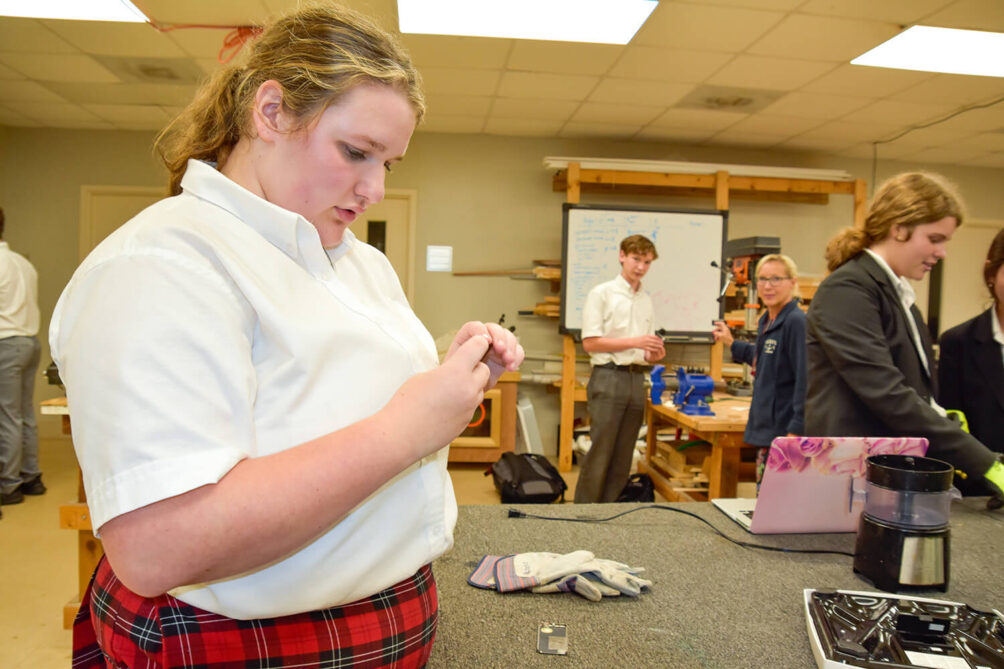National STEM Day with Ms. Gaston-Jones.
St. Luke's: Tell us a little bit about yourself
Susan Gaston-Jones: I have spent a lifetime being a slave to curiosity and all these puzzles, legos, and builds. I am always challenged,
invigorated and inspired when I am working on a project of this nature. As a little girl my parents always encouraged me to question and wonder. In school I was placed in a special program that fostered and developed all of that natural curiosity and provided me with opportunities to engage, explore and experience a non- traditional learning experience. As I got older it occurred to me that such experiences should not be limited to a few students but rather should be the norm in all classrooms.
SL: Why did you pursue teaching as a career?
SGJ: My own love of learning, school and academic pursuit led me down a clear path to becoming a teacher. I have
literally always known I wanted to be a teacher and I “pretended” being a teacher all the time as a child. I turned
my bedroom in to a classroom and I lined up all of my dolls and stuffed animals on the perimeter of my bed and conducted class. I had a chalk board in my room and I taught lessons regularly.
SL: What is the best part about being a teacher?
SGJ: The best part about being a teacher in real life is the interaction and relationships I’ve been privileged to create
with my students. My human students are a lot more engaging than my dolls were! Seriously though the satisfaction that comes with teaching is like no other profession because we have the opportunity to meet people at a time in their lives when everything isn’t really figured out yet and as teachers we hopefully can come along beside them and offer guidance and inspiration as they chart a path for the rest of their lives.
SL: What do you like about teaching STEM classes?
SGJ: Teaching STEM allows me to marry my two passions of science and math and in new, innovative ways. The
lessons vary a lot as well so the fear of work becoming stale is never even a possibility. I am fortunate to have an administration that allows me the freedom to write my own curriculum and to consider what the students’ interests are and current tech trends when my lesson plans are being developed.
SL: What is your philosophy on STEM education?
SGJ: STEM education should reflect current technology while feeding the natural curiosity of humankind. I love it when my students can influence what I plan as it allows for “buy-in” and my students become the stakeholders. Also, collaboration with other departments/teachers has been a welcomed addition to my curriculum here at St. Luke’s. Working with Biomed on the Operation Game was so satisfying and it allowed me to peek in to that world.
Due to the success of said collaboration, there will be another collaboration with biomed this year, as well as, with our art department.
SL: What are your must-have STEM items for your classroom?
SGJ: My goal for our STEM program is to provide students with unique learning experiences and as such I have added new projects for this year. An academic school year is already divided in to 4 quarters so I divided our STEM year in to 4 unique projects. Quarter one was dubbed “Tinkering 101” and found the students exploring obsolete and current machines that were either working or broken in some way. Due to the generous donations of faculty and parents, we had a variety of machines which gave the students an abundance of options. Their assignment was to choose one of the following options: 1) to take a broken machine and fix it so that it operates as it was
originally intended, 2) take a broken machine, fix it, but reinvent it to perform a new function, or 3) forage broken multiple machine parts to create an entirely new invention. The students made their machines, demonstrated them to their classmates, made a slideshow chronicling their invention journey and they all made a product manual (with multiple languages) to accompany their machine! Quarter two is a collaboration with Biomed to make a heart that will pump blood through a “patient’s” body. Quarter three is a collaboration with the art department to build a mini gold course (think Rube Goldberg) and quarter four is a unique Lego build that is a surprise!
SL: What is 1 goal you hope will be accomplished in the STEM program one year from now?
SGJ: There is also a separate special project with two students involving playing chess remotely from two different locations. This is a year long project that we endeavor to unveil by the end of the school year.
SL: What do you think is the most important thing STEM teachers can do to help students succeed?
SGJ: If you were to ask me the one thing I think we as teachers need to provide out STEM students I would have to say an endless supply of open minded attitudes. Students need to be assured that their ideas are always welcomed and most of the time can be a reality with a little support from our academic community and that is where St.
Luke’s always come through! I have never worked anywhere else (and this is my 18th year of teaching) in which all of our community comes together to provide everything needed to accomplish the goals and projects from which our students so richly benefit.
SL: Anything else that you want to tell us about teaching STEM?
SGJ: Here at St. Luke’s no dream is too lofty and we will do our best to imagine new ways to learn and experience
learning in unique ways with the ultimate goal of assisting students’ journeys of discovery!
Thanks Ms. Gaston-Jones for helping us celebrate National STEM Day!

